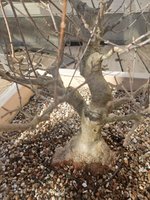leatherback
The Treedeemer
I am thinking about howto's in nebari development and tried to see all I could on the method made famous by ebihara.
I am however wondering what the KEY component of the method is. I see a lot of people putting focus on organizing the roots and screwing the tree to the board. I however cannot help but wonder whether that is the core of the technique. I doubt this will cause the roots to fuse (much) more than under normal well-managed conditions.
Could it be that tying to roots down onto the board so they grow flat rather than round, is more important?
Any thoughts?
I am however wondering what the KEY component of the method is. I see a lot of people putting focus on organizing the roots and screwing the tree to the board. I however cannot help but wonder whether that is the core of the technique. I doubt this will cause the roots to fuse (much) more than under normal well-managed conditions.
Could it be that tying to roots down onto the board so they grow flat rather than round, is more important?
Any thoughts?




